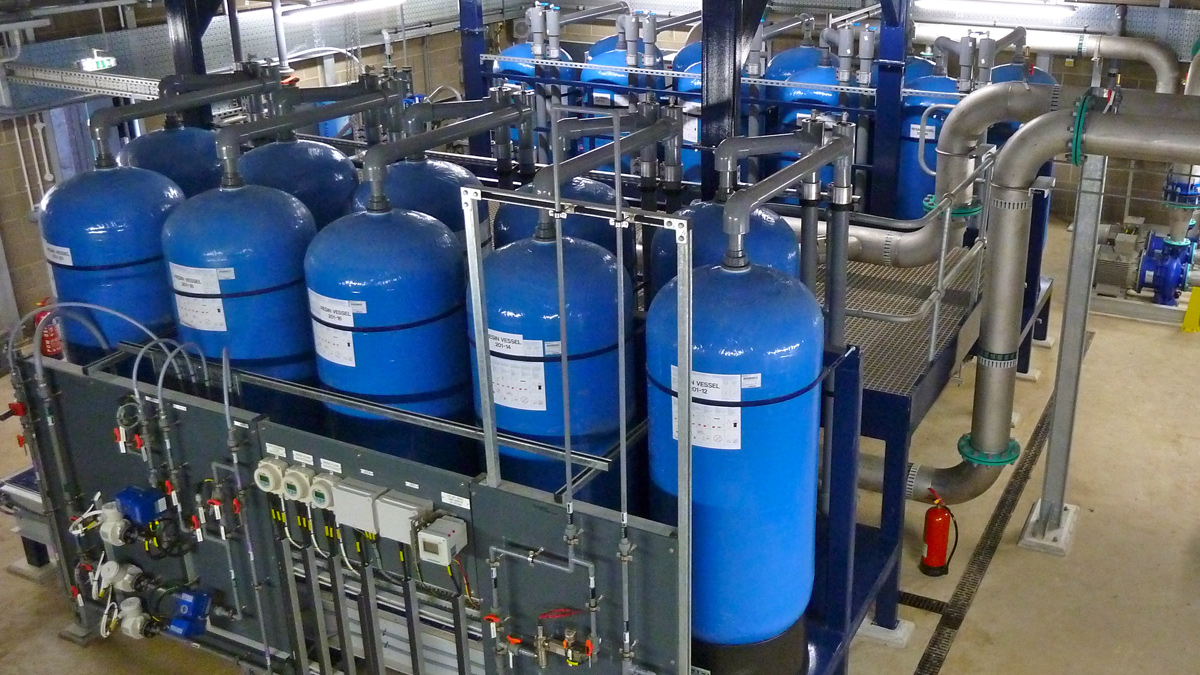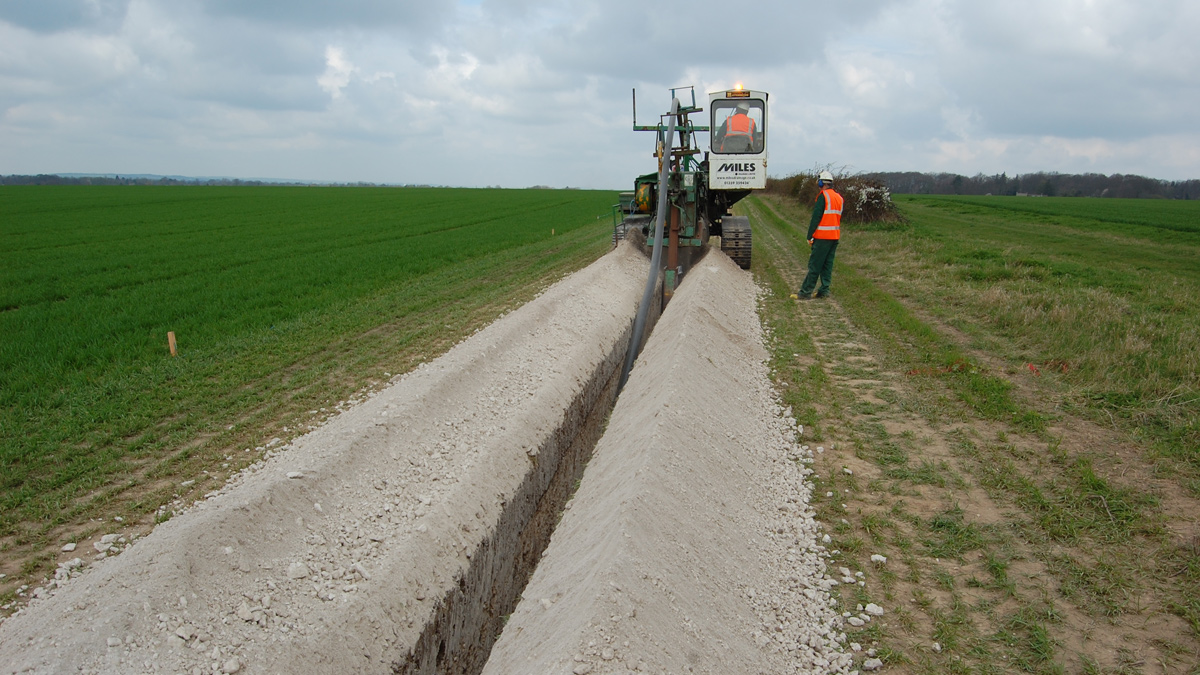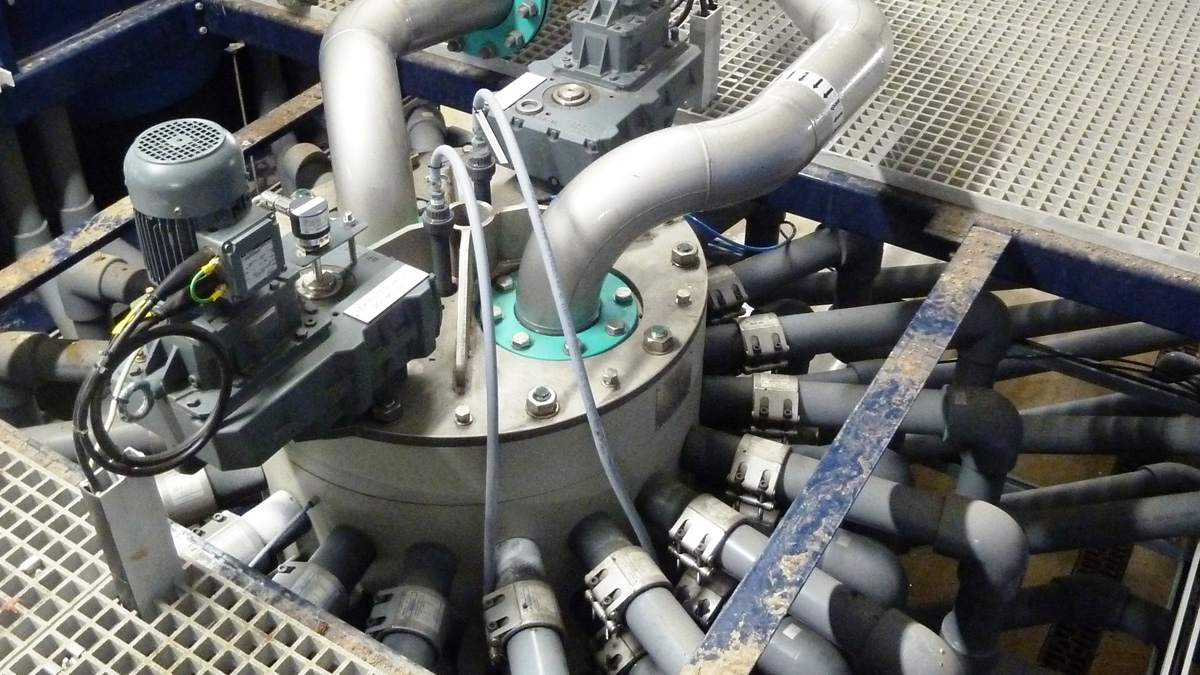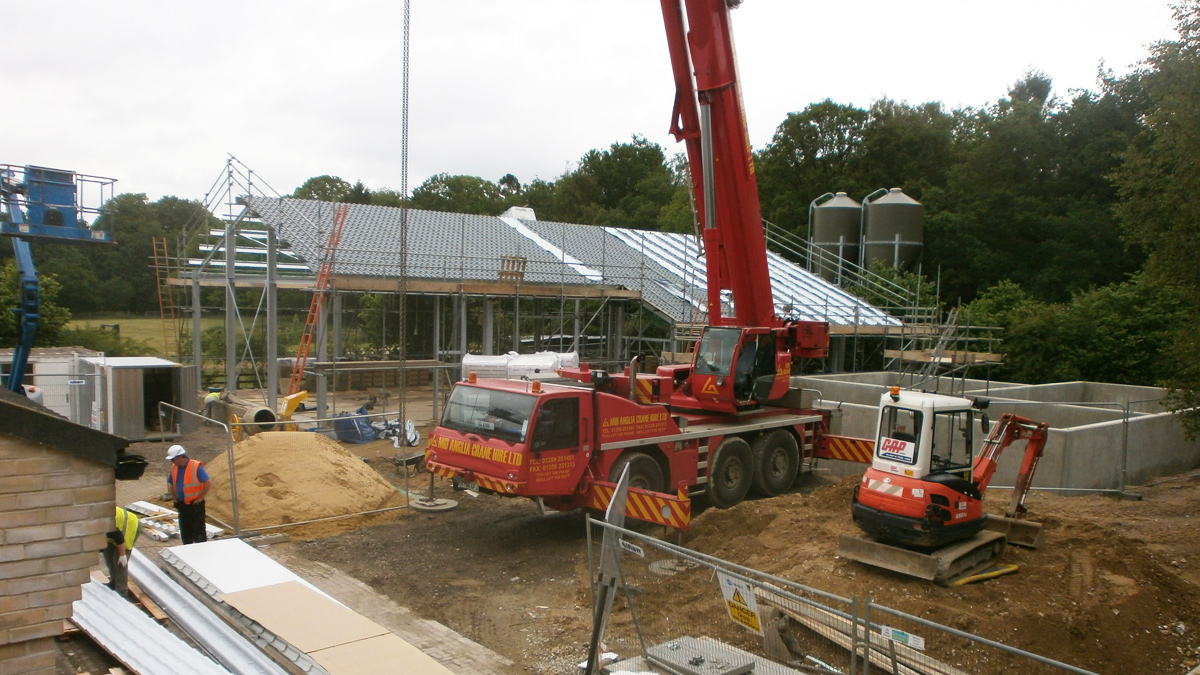Nitrate Management Programme (2012)

Cambridge Water Company (CWC) delivers potable water to approximately 300,000 customers spread over an area of 453 square miles in and around Cambridge. The water sources, with a maximum daily license output of 130Mld, are exclusively boreholes drawing water from a predominantly chalk aquifer where nitrate levels have been steadily rising over the past 30 years. This challenge is being met by the construction of ion exchange nitrate removal plants at Babraham, Euston and Fleam Dyke Pumping Stations together with a non-treatment zonal management strategy for Morden Grange Pumping Station. These will enable compliance with the regulatory standards for nitrate concentrations for these sources through to 2035.
Introduction
CWC appointed Mouchel in August 2010 to provide nitrate consultancy services and project management. Mouchel’s role included feasibility studies, outline design, whole life cost modelling, procurement and construction contract supervision, together with the management of issues around land, planning and environment, and liaison with stakeholder bodies including, inter alia, the Environment Agency, Anglian Water Services (AWS), Parish Councils, Natural England and the RSPB.
In Phase 1 Mouchel reviewed the available data and investigated alternative engineering, groundwater and waste disposal options to meet the requirements of Cambridge Water’s quality enhancement undertaking to the Secretary of State at least whole life cost, based on a 25 year model.
Modelling
Infoworks WS hydraulic modelling software was used to develop scenarios to confirm the technical feasibility for a range of preferred options. The assumption made was that each nitrate removal site should produce water with a nitrate concentration of 40mg/l to allow for in-network blending with other sources to enable compliance with the regulatory Prescribed Concentration Value (PCV) of 50mg/l.
Alternative treatment options considered included ion exchange, reverse osmosis, electrodialysis, and biological denitrification. Options for waste disposal were considered too; these included connecting to an AWS sewer or tankering by road to a suitable reception facility. Longer-term solutions for use of the waste stream were also considered, and CWC/Mouchel are continuing to work with organisations like the National Industrial Symbiosis Programme to identify potential non-waste uses for the nitrate removal plant discharge stream. Investigations into groundwater extraction licence trading, new borehole water source construction and catchment management also informed the project and the least whole life cost model.

Installation of waste pipeline – Courtesy of Mouchel
At PR09, CWC submitted plans to OFWAT identifying a requirement to construct nitrate removal plants at several sites during AMP5, based on a preliminary investigation undertaken by Mouchel.
Continuing work undertaken by Mott MacDonald in AMP4, wherein they undertook a detailed study to investigate the relationship between historical nitrate data and the geophysical characteristics of the aquifer at all of CWC’s groundwater borehole locations, Mouchel carried out further analytical work. This identified that the proposed nitrate removal solution for one of the sites initially identified at PR09, namely Morden Grange Pumping Station, could be replaced with a simpler network solution requiring only pressure booster pumps.
Ultimately, together with the Morden Grange network solution, three base-load water supply boreholes at Babraham, Euston and Fleam Dyke were chosen as the key sites for the construction of new nitrate removal plants during AMP5, to be built during 2011, 2012 and 2014 respectively.
Planning, land, environment & power requirements were considered in detail at each of the potential site locations that enabled constraints to be addressed at an early stage.
The Phase 1 Report and its recommendations were presented to and approved by CWC’s Executive Team in January 2011 and Mouchel were asked to proceed with the Phase 2 solution implementation and programme management.

Multiport valve – Courtesy of Mouchel
Procurement strategy
Mouchel completed outline designs prior to an extensive contractor pre-qualification. Tenders for the three nitrate removal plants were sought from five contractors based on the I.Chem.E. “Red Book” form of Contract and an ion exchange (IEX) treatment process. Lump sum contracts were awarded to MWH Treatment for the plants at Babraham and Euston with a further agreement from MWH to undertake the works at Fleam Dyke on a lump sum basis. The ion exchange nitrate removal technology is that provided by ACWA’s NITREAT process.
The nitrate-selective resin is packed into 20 (No.) vessels located around a patented multi-port valve. At any one time 70% of the resin vessels are in the adsorption phase of the treatment cycle during which the nitrate ions are replaced by chloride ions. The remainder of the vessels are in a regeneration phase. Regeneration of the resin is achieved by exposure to a brine solution.
The process is PLC controlled and maintains a defined nitrate level regardless of raw water nitrate levels or flow rates. The plants are designed to reduce nitrate in a side stream volume (of approximately 10% of the borehole peak flow volume) to around 4mg/l such that when blended back with the remaining borehole flow leaving the site the water delivered to customers has a nitrate concentration of around 35-40mg/l.
The 3 (No.) booster pumping stations required for the Morden Grange rezone management solution were competitively tendered in a separate procurement exercise. The lump sum I.Chem.E. “Orange Book” forms of Contract were awarded to MWH Direct
Babraham Nitrate Removal Plant
With a Contract award in June 2011, a start on site was achieved on 25 July 2011. Although the site was in a greenbelt, planning permission was obtained for the 18m x 12m steel framed building and external tanks. The roof tiles and bricks were selected to match the existing borehole pumping station on site.
In parallel with the plant design, negotiations with AWS took place to agree Trade Effluent Discharge Consent for the waste stream produced by the nitrate removal process that is discharged to their sewerage system via a 3km long, 100mm diameter, MDPE pumped main. The waste stream from the process is high in chlorides because the resin used for the ion exchange is regenerated using brine.
Due to its proximity to known archaeological features, a detailed magnetic survey (gradiometry) was undertaken on three alternative discharge pipe routes together with an archaeological survey at trial pit locations excavated to inform the pipeline design. The discharge pipe was laid using a trenching machine without topsoil stripping to minimise disturbance to the arable land and to any archaeology. Takeover by CWC with the plant running into supply took place on 29 March 2012, complying with the DWI Undertaking.

Babraham salt saturator & waste tank – Courtesy of Mouchel
Euston Pumping Station
The Contract for the IEX Plant at Euston was let on 1 February 2012. The design is virtually the same as at Babraham but instead of having one NITREAT skid with 20 vessels, it has two, which means that the building is much larger at 25m x 14m. The location is remote from Cambridge and is some 5km south of Thetford in Suffolk. The water source is from two boreholes, one at Brettenham and the other at Euston, which supply the Cambridge network via the 55km Thetford Main.
Trade Effluent Discharge Consent has been agreed with AWS to discharge the waste stream from this plant into their sewerage system in Thetford.
Unlike at Babraham however, this waste stream requires dilution so that the chloride levels are less than 5,000mg/l. The 5km route for the pumping main has various environmental constraints and physical obstacles to overcome including a Special Protection Area (SPA) for Stone Curlews, a bridge that is a Scheduled Ancient Monument, the rivers Thet and Little Ouse, a Nature Reserve and a line of protected trees.
Construction of the plant is in progress with water into supply scheduled for the end of 2012.

Euston site – Courtesy of Mouchel
![]() Morden Grange Pumping Station
Morden Grange Pumping Station
The nitrate management strategy for the rising levels in the Morden Grange source is a zone management strategy in which the source is shut down when rising nitrate levels reach a pre-determined target set just below the PCV of 50mg/l.
Under these conditions water from an adjacent lower nitrate source is imported into the zone. The loss of Morden Grange Pumping Station would reduce pressure service in the supply zone to below the minimum standard under certain network demand conditions. Pressure service is restored by booster pumps, requiring the construction of three booster pumping stations; one, constructed at CWC’s borehole pumping station at Fowlmere, to boost water from Duxford Grange to the Heydon Service Reservoir (SR), and two others to maintain pressures in distribution located at new sites in the villages of Litlington and Meldreth.
The Fowlmere booster pump, rated at 37l/s with duty/standby Grundfos variable speed pumps, is located within the existing CWC borehole site within a brick-effect GRP kiosk. Litlington and Meldreth boosters are on Greenfield sites in the corners of arable fields that have needed planning permission and land purchase. Both these are housed within green GRP kiosks. They will be controlled so as to maintain pressures in the distribution system when the zone is supplied from Heydon SR rather than Morden Grange. Operation will be possible from the CWC control room via a radio-telemetry system. The boosters at Fowlmere and Litlington were commissioned in June 2012, the third, at Meldreth, is due for completion in the summer of 2012.
Fleam Dyke Pumping Station
The third nitrate removal plant at Fleam Dyke Pumping Station is currently planned for construction in 2014. There has been a pumping station at this site since 1910 and was the first source of supply for the University & Town Waterworks Company that later became Cambridge Water Company. The grounds are in a County Wildlife Site, designated for species-rich chalk grassland. There is an SSSI adjacent to the site that is also designated for chalk grassland. This has been taken into account in the location of the proposed plant within the pumping station site and a mitigation strategy involving the preservation of chalk grassland at this and other CWC sites will be implemented as part of the development.
Costs
This is the largest capital programme that CWC has undertaken since construction of the Thetford Main in 1991, and has a total value of £7.5m. Costs for individual nitrate removal plants are in the order of £1.7m to £2.5m.
The team
The programme is being delivered for CWC by Mouchel (Gary Deakin – Project Manager), MWH Treatment (Mark Watson – Project Manager) and MWH Direct (Phil Healey – Project Manager) based in offices in Heywood, Lancashire and Haywards Heath, Sussex.


